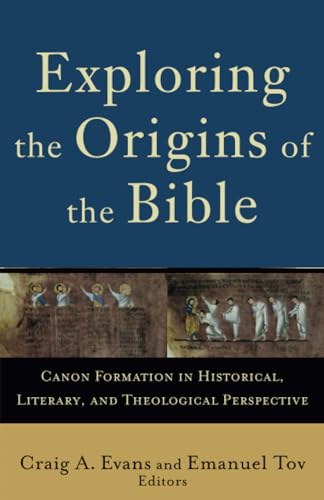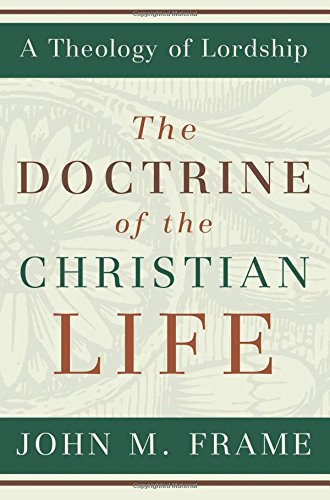Exploring the Origins of the Bible: Canon Formation in Historical, Literary, and Theological Perspective
Written by Craig A. Evans and Emanuel Tov, eds. Reviewed By David G. Graves“Exploring the Origins of the Bible is the result of a special Spring session of the Hayward Lectures at Acadia Divinity College in Wolfville, Nova Scotia, that took place in April 2006” (p. 7). The book consists of eight essays derived from these lectures: Emmanuel Tov, “The Septuagint as Literary Analysis of Hebrew Scripture”; James H. Charlesworth, “Writing Ostensibly outside the Canon”; Stephen G. Dempster, “Torah, Torah, Torah: The Emergence of the Tripartite Canon”; R. Glenn Wooden, “The Role of ‘the Septuagint’ in the Formation of the Biblical Canons”; Craig A. Evans, “The Apocryphal Jesus: Assessing the Possibilities and Problems”; Stanley E. Porter, “Paul and the Process of Canonization”; Lee Martin McDonald, “Wherein Lies Authority? A Study of Books, Texts, and Translations”; and Jonathan R. Wilson, “Canon and Theology: What is at Stake?”
Exploring the Origins of the Bible is an introductory volume for a theological student to understand the various historical issues related to the compilation and growth of the canon. As with all such edited volumes, the various essays evince a varied quality and usefulness. The first six chapters serve admirably for the stated purpose of this volume. Emanuel Tov’s essay is quite similar to material one finds in other works of his. Stanley Porter’s essay takes the various theories given for the rise of the Pauline corpus and concludes that the evidence seems to support the thesis that the collecting of these letters began during Paul’s life.
The final two essays, however, do not prove to be as helpful. Both McDonald’s and Wilson’s essays engage in some problematic argumentation. McDonald’s essay has several deficiencies, including multiple logical fallacies and unsupported assumptions. For example, McDonald makes an appeal to authority when he says, “most scholars … most biblical scholars” without giving names or argumentation for the multiple-source theory of 2 Corinthians (p. 211). He then makes an unwarranted deduction that because none of the extant manuscripts support the multiple-source theory for 2 Corinthians, we must have sloppy manuscripts, and therefore the idea of seeking the “original manuscript” is too complex. (I do not have a settled position on the composition of 2 Corinthians; rather I am using this as an example of McDonald’s method.)
Elsewhere McDonald engages in an ambiguous use of language to sow doubt and suspicion. He states, “Historically, of course, the church has never fully agreed on which books comprise its Bible” (p. 209). This sentence is deceptive and belies the fact that ecclesiastical bodies have generally agreed that there is a canon of Scripture, and the various bodies have identified a canon without sinking into despair because they are not in absolute agreement with other ecclesiastical bodies. A numerical plurality does not necessarily equate to qualitative pluralism.
This poisoning of the well does not seem unintentional on McDonald’s part. In fact, this doubt plays into McDonald’s communitarian hermeneutic, which vests authority in the person of God and not in the text. This in reality is part of McDonald’s agenda. He seems to desire to muddy the waters in order to get those ecclesial bodies who do not agree to make their views more provisional. He takes a true statement that all authority is vested in the Lord Jesus Christ as Jesus stated in Matt 28:18: “All authority in heaven and on earth has been given to me.” From this statement McDonald urges Christians not to place authority in Scripture, with the implication that such a move will somehow practically invalidate Christ’s authority. In other words, McDonald is trying to bring up the specter of that dreaded “bibliolatry.” Such veiled moves do not lessen the poisoning of the well or strengthen McDonald’s argument. In fact it is better to say that McDonald spends the first thirty-four pages of the essay raising difficulties in the transmission of the text in order to bring in his alternate theory, which amounts to little more than a priesthood of textual critics. As Adolf von Harnack stated, “the auctoritas interpretiva is invariably the supreme and true authority” (cited in Herman Bavinck, Reformed Dogmatics[Grand Rapids: Baker, 2003], 1.63).
McDonald is careful to note that with all the problems in the transmission of the text, the churches are still not left wondering, who is Christ? Or what is his Gospel? So despite the various difficulties that McDonald raises and the call to worship Christ and not the text of Scripture, one is left at the end of the day wondering how the first thirty-four pages and the last two fit together. They seem like what Macbeth called “a tale … full of sound and fury signifying nothing.” For after raising jeremiads concerning the lack of recoverability of the urtext of the NT, McDonald out of scholarly honesty is forced to admit, “Remarkably, the various translations and biblical canons present in churches today (Greek Orthodox, Roman Catholic, Ethiopian, and Protestant) all reflect the message and identity of Jesus the Christ as well as the obligation of the church for worship and mission” (p. 238). One feels like quoting Kenneth Kitchen’s response to the biblical minimalists: “Your fantasy agendas are irrelevant in and to the real world, both of today and of all preceding time back into remotest antiquity. Get real or (alas!) get lost!” (On the Reliability of the Old Testament [Grand Rapids: Eerdmans, 2003], xiv.)
Despite the concluding two essays, which are works of postmodern sturm und drang, this volume could prove a helpful text for introducing students to the complexities in understanding the historical process in which the text of Scripture came to the church today. The reader must be aware, however, that it is from a historical-critical approach and lacks the theological and dogmatic sensitivity that one would expect when it comes to treating such a theological topic as how the Bible has come to the church today.
David G. Graves
Oikos Community Church
Hilliard, Ohio, USA
Other Articles in this Issue
We begin with a question of translation. Many translations place a period after the word “conviction” in 1 Thess 1:5: “in power and in the Holy Spirit and with full conviction...
The Inexhaustible Fountain of All Good Things: Union with Christ in Calvin on Ephesians
by Lee GatissJuly 10, 2009 was the 500th birthday of the acclaimed French Reformer John Calvin...
The name of Martin Luther is perpetually linked to the doctrine of justification by faith alone...
Of the many questions currently surrounding the discussion about justification, the relationship between justification and spiritual fruit merits attention...
Every year a few students ask me my thoughts about whether they should pursue doctoral studies and I respond with what has come to be known as ‘The Speech...






